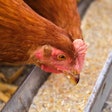
Pellet size is important in animal feed, but research shows that in general, the pelleting process reduces nutrient availability, according to Joseph Moritz, associate professor and state extension specialist, West Virginia University. Moritz presented this information at the U.S. Poultry & Egg Association’s Feed Mill Management seminar in Nashville.
“Pellet quality is important,” he said. “It is probably more of a perception for independent mills. However, for integrated mills it is definitely an economic consideration.”
Problems with past research
While basic pelleting techniques are well documented, there are legitimate concerns with past pelleting research, Moritz said. Not all variables were recorded in past research, which makes building on the work difficult. In specific, he noted that few studies differentiate between effects on feed form and nutrient availability (negative or positive).
Increasing pellet quality
Moritz noted that there are a number of ways to increase pellet quality:
- Slow down production rate. However, Moritz noted that in the current economy, this is not really feasible.
- Use a thicker pellet die. However, this slows down production, which is also not economically feasible.
- Increase steam conditioning temperature. However, mills are reluctant to do this for fear of slipping the die or blocking the dump.
- Use a pellet binder. There are a wide variety of these, each with their own properties, positive and negative.
- Decrease corn particle size. Moritz said the usual recommendation is to go below 600 microns to get better pellet quality. However, many nutritionists now say that with corn, feed mills should stay above 600 microns, as going too small can cause the nutrients to pass through the animal too quickly. As a result, many nutritionists are recommending 800 microns as a better size.
- Manipulate diet formulation. By increasing protein content, you also can get a higher quality pellet.
Study: examining pellet form
Moritz referenced two studies; one where nutrient availability was maintained and pellet form was changed, and one where pellet form was kept the same but nutrient availability was varied.
In the first study, the feed forms were high pellet quality, medium pellet quality, low pellet quality and ground pellets. The study showed there was very little difference in carcass weight between the ground pellets, the low pellet quality form and the medium pellet quality form. Only the high pellet quality form showed a difference that was worth noting. “If you really want to see significant change, you really need to get up to that high pellet quality range,” Moritz said.
Study: examining nutrient availability
In the second study, lysine was added to feed, and control amounts were subjected to different conditions—smaller amounts of lysine, double pelleting and unprocessed mash. Ultimately, the results indicated the best performance came from feed that had no form. “Once you eliminate feed form, you really get better performance out of your animals with unconditioned mash, or unprocessed mash,” he said.
“What do I think we should do? Try to create the best pellet possible, because even if there is nutrient detriment, the feed form effects overshadow that,” he said.
Use of DDGS
Moritz noted that most mills are using DDGS, even though DDGS are detrimental to pellet quality and detrimental to throughput. However, he added that the DDGS industry is changing, which may impact the industry’s DDGS usage.
“Pellet quality has economic importance,” he summarized. “Nutrition may be compromised, but feed form overshadows that compromise.” He added that he thinks with more research a way will be discovered to maximize pellet quality without causing a decrease in nutrient availability.
“I do think DDGS inclusion decreases pellet quality as well as throughput, and to simultaneously solve these problems will be very difficult,” he added. “Perhaps with these new DDGS coming on the market we’ll have fewer issues with throughput. However, I’m guessing we’ll have increased issues with pellet quality.”
















